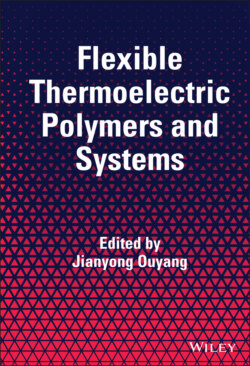Читать книгу Flexible Thermoelectric Polymers and Systems - Группа авторов - Страница 29
1.3 Peltier Cooling
ОглавлениеThe Peltier effect can be used for thermoelectric cooling. The Peltier cooling principle is quite different from the conventional cooling technologies that usually use compressed liquid or gas. Because of the compressor and circuit fluid, the conventional cooling instruments like air conditioners and refrigerators are quite bulky, heavy, and noisy. No moving part is required for a Peltier cooler; it is thus quiet and can have a very small size.
As shown in Figure 1.24, when an electrical current passes through the thermoelectric legs, both the electrons in the n‐type leg and holes in the p‐type leg transport from the cold side to the hot side. The charge carriers bring heat from the cold side to the hot side and thus cool down the cold side. The heat pumped at the cold side is Π×I, where Π is the Peltier coefficient and I the current density. Π is related to the Seebeck coefficient by the Kelvin relationship, Π = S×T.
Apart from the Peltier cooling, Joule heat is generated by the electrical current, and heat is transferred from the hot side to the cold side due to the temperature gradient. Half of the overall Joule heat transports to the cold side or the hot side. By neglecting the Thomson effect, the heat absorption at the cold side of a thermoelectric leg is given by
Figure 1.24 Schematic illustration of thermoelectric cooling. An external electricity source is connected to the two legs, and electrical current flows from the n‐type leg to the p‐type leg. The curved arrows indicate the transportation of the charge carriers from the cold side to the hot side in the thermoelectric legs.
where R is the electrical resistance of the thermoelectric leg, K the thermal conductance of the thermoelectric material, and ΔT = T H − T C.
The input power by the electricity includes the heat pumping and the Joule heat,
(1.74)
The ratio of the heat absorbed at the cold side to the input electrical power is the energy efficiency of cooling. It is called as the coefficient of performance (COP),
(1.75)
As shown in Eq. (1.73), the rate of heat pumping is a quadratic equation of the current I. There is a maximum rate of heat pumping. The corresponding current at the maximum heat pumping rate is given by
(1.76)
At this maximum cooling rate, the corresponding COP is given by
(1.77)
The electrical current at the maximum cooling rate is different from that corresponds to the maximum COP. The electrical current corresponding to the maximum COP is given by
(1.78)
The maximum COP is shown by the Eq. (1.79),
The maximum temperature difference between the hot and cold sides is given by
(1.80)
This indicates that thermoelectric materials with a high Z value are needed for efficient thermoelectric cooling. When the Z value is higher, lower temperature at the cold side can be achieved.
